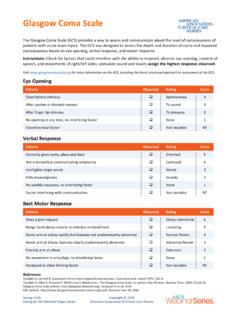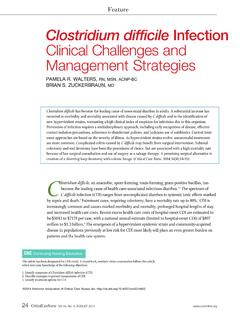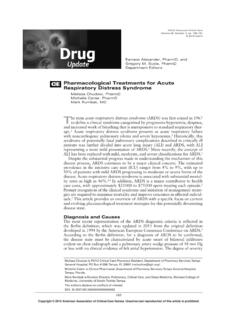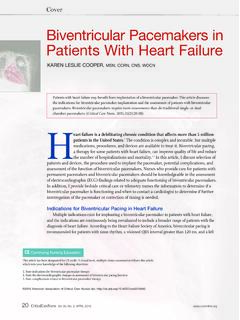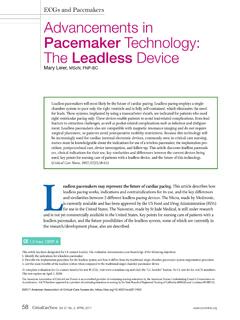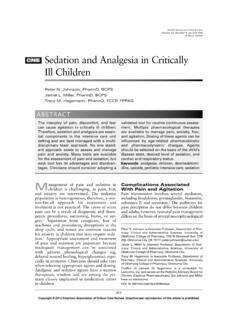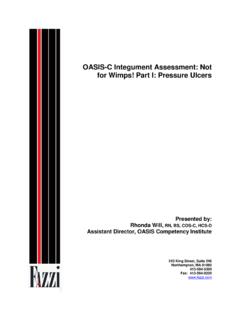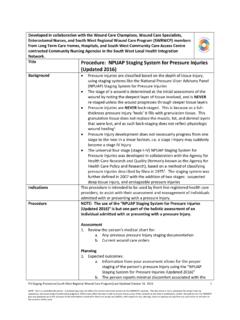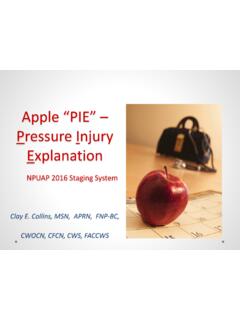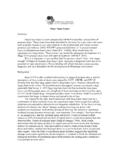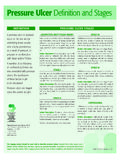Transcription of Evidence-Based Prevention of Pressure Ulcers in …
1 The development of hospital-acquired Pressure Ulcers is a great concern in healthcare ulcer treatment is costly, and the development of Pressure ulcerscan be prevented by the use of Evidence-Based nursing practice. In 2008, the Centersfor Medicare and Medicaid Services announced that they will not pay for additionalcosts incurred for hospital-acquired Pressure development of a stage III orIV Pressure ulcer is now considered a never event. 2 This change has resulted in an increased focuson preventive strategies and institutional scrutiny of Pressure Ulcers that develop in patients afterhospital admission. The cost of 1 stage III or IV Pressure ulcer may be between $5000 and $50 actual cost of Pressure Ulcers is not known because it is unclear what costs were included inestimates, such as nursing care costs, material costs, and added acute care days related to the devel-opment of a Pressure the intensive care unit (ICU), patients have multiple factors thatincrease the risk of Pressure Ulcers developing.
2 Typically the patient has respiratory equipment,urinary catheters, sequential compression devices, multiple intravenous catheters, and the infusionof vasoactive agents for hypotension that may contribute to inability to turn patients and increasethe risk of Pressure ulcer development. This article discusses the multiple risk factors present incritical care for the development of Pressure Ulcers , current practices, and evidence for interven-tions aimed at preventing Pressure Prevention of PressureUlcersin the IntensiveCare UnitKAREN L. COOPER, RN, MSN, CCRN, CNS, WOCN 2013 American Association of Critical-Care Nurses doi: and Wound CareThe development of stage III or IV Pressure Ulcers is currently considered a never event.
3 Critical care patientsare at high risk for development of Pressure Ulcers because of the increased use of devices, hemodynamic instabil-ity, and the use of vasoactive medications. This article addresses risk factors, risk scales such as the Norden,Braden, Waterlow, and Jackson-Cubbin scales used to determine the risk of Pressure Ulcers in critical carepatients, and Prevention of device-related Pressure Ulcers in patients in the critical care unit. (Critical CareNurse. 2013;33[6]:57-67) 33, No. 6, DECEMBER 201357 This article has been designated for CNE credit. A closed-book, multiple-choice examination follows this article,which tests your knowledge of the following objectives:1. Identify factors that place critically ill patients at increased risk for Pressure ulcers2.
4 Describe the Pressure risks associated with commonly used devices in the critical care setting3. Apply Evidence-Based strategies for the Prevention of Pressure Ulcers in critical care patientsCNE Continuing Nursing EducationIncidence of Pressure Ulcers in ICUsMultiple studies of the prevalence and incidence of pres-sure Ulcers have been done. Prevalence studies involve asnapshot of current Pressure Ulcers in a given unit on agiven , the hospital assesses all patients skinto determine if each patient exhibits the physical signs ofa Pressure ulcer , and if so, the Pressure ulcer is staged. Theincidence of Pressure Ulcers indicates the number of patientsin whom Pressure Ulcers develop in a given health studies1,4-7show that the incidence ofpressure Ulcers in the ICU ranges from 10% to 41%.
5 Classification of Pressure UlcersThe National Pressure ulcer Advisory Panel ( npuap )revised its Pressure ulcer classification in 20078(Table 1).Previously, Pressure Ulcers were classified as stage I throughstage IV, or as unstageable. In areas such as the heels, scalp,malleolus, or ears, the lack of subcutaneous fat layersmakes progression of Pressure Ulcers from stage II tostage III or IV a concern (Figures 1 and 2). A new classifi-cation, deep tissue injury , is now included. Suspecteddeep tissue injury is described as a bluish or purple areaof discoloration over an area of Pressure or shear that maybe difficult to discern in patients with dark skin. It mayalso appear as a blood-filled blister. deep tissue injurymay develop into a full- or partial-thickness Pressure depth of injury in a suspected deep tissue injury maynot be evident at the time of identification.
6 This injurymay resolve or develop into a stageable Pressure ulcer .(Table 2 lists websites offering additional informationand pictures of Pressure Ulcers .) In 1989, Karen Lou Kennedy, RN, CS, FNP,first describeda Pressure ulcer seen in terminal patients receiving long-term care. This ulcer is a rapidly progressing pressureulcer seen in terminal patients with hours or days ,10 The Kennedy terminal ulcer is not currentlydescribed in national or international Pressure ulcerguidelines, but critical care nurses should be aware ofthis ulcer classification as a potentially unpreventablepressure ulcer that may be seen in patients in whom deathis imminent. The Kennedy terminal ulcer is most oftenseen in patients admitted to the ICU from long-term care58 CriticalCareNurseVol 33, No.
7 6, DECEMBER L. Cooper is a clinical nurse specialist at Sutter Auburn FaithHospital in Auburn, author: Karen L. Cooper, RN, MSN, CCRN, CNS, WOCN,Sutter Auburn FaithHospital, 11815 Education St, Auburn, CA 95602 (e-mail: purchase electronic or print reprints, contact the American Association of Critical-Care Nurses, 101 Columbia, Aliso Viejo, CA 92656. Phone, (800) 899-1712 or (949)362-2050 (ext 532); fax, (949) 362-2049; e-mail, IStage IIStage IIIS tage IVUnstageableDeep tissue injuryKennedy terminal ulcerDescriptionNonblanchable area of redness over a bony prominence. If a stage I Pressure ulcer is suspected, the nurseshould reevaluate the reddened area at the next skin inspection or turning activity to determine if the red-ness is still present.)
8 Reactive hyperemia is a common condition that occurs with localized tissue pressuresuch as occurs when legs are crossed, and normal tissue colors returns when the Pressure is relieved. Ifthe reddened area is still nonblanchable, it should be considered to be a stage I Pressure skin loss (limited to the epidermis) that may be described as a clear fluid-filled blister orshallow wound with a pink-red wound wound, loss of the epidermis, and invasion into the dermis. Stage III Pressure Ulcers do notinvolve loss of muscle, nor do they expose tendon, muscle, or bone tissue . In body areas that do not havesubcutaneous fat layers such as the ears, nose, scalp, or malleolus, Pressure Ulcers that appear to be par-tial thickness should be considered a stage III Pressure ulcer (Figure 1).
9 Full-thickness loss of the epidermis and dermis and extension into muscle layers. Bone, tendon, and muscle maybe exposed. If cartilage, bone, or tendon is exposed in body areas that do not have layers of subcutaneousfat such as the ear, nose, scalp, or malleolus, the wound should be classified as a stage IV Pressure in which the wound bed is covered with eschar or slough. Eschar is a hard, thick, black, brown, ortan scablike covering of the wound. Slough is a white, tan, gray, or green tissue or mucuslike substancecovering the wound bed8(Figure 2).A bluish or purple area of discoloration over an area of Pressure or shear that may also be described as ablood-filled ulcer that rapidly develops into a full-thickness wound.
10 A pear, butterfly, or U -shaped ulcer in the sacrum,or a very small stage I or II area that rapidly progresses to a stage III or stage IV ulcer within 1 Classification of Pressure ulcersfacilities. I have seen 2 rapidly developing Pressure ulcerswith the butterfly pattern in patients with septic shockwho died within hours of admission to the ICU. Pressure ulcer Risk Assessment ScalesMultiple risk factor scales have been developed, butthey do not reflect the additional risk factors present inthe ICU. The most common risk scales used in the UnitedStates are the Braden Scale and the Norton Scale. These2 Pressure ulcer risk scales are recommended by theAgency for Health Care Policy and mostcommon Pressure ulcer risk scales used in Britain are theWaterlow and Braden Jackson Cubbin RiskAssessment Score is a Pressure ulcer risk tool specific toEuropean critical care units (Table 3).
